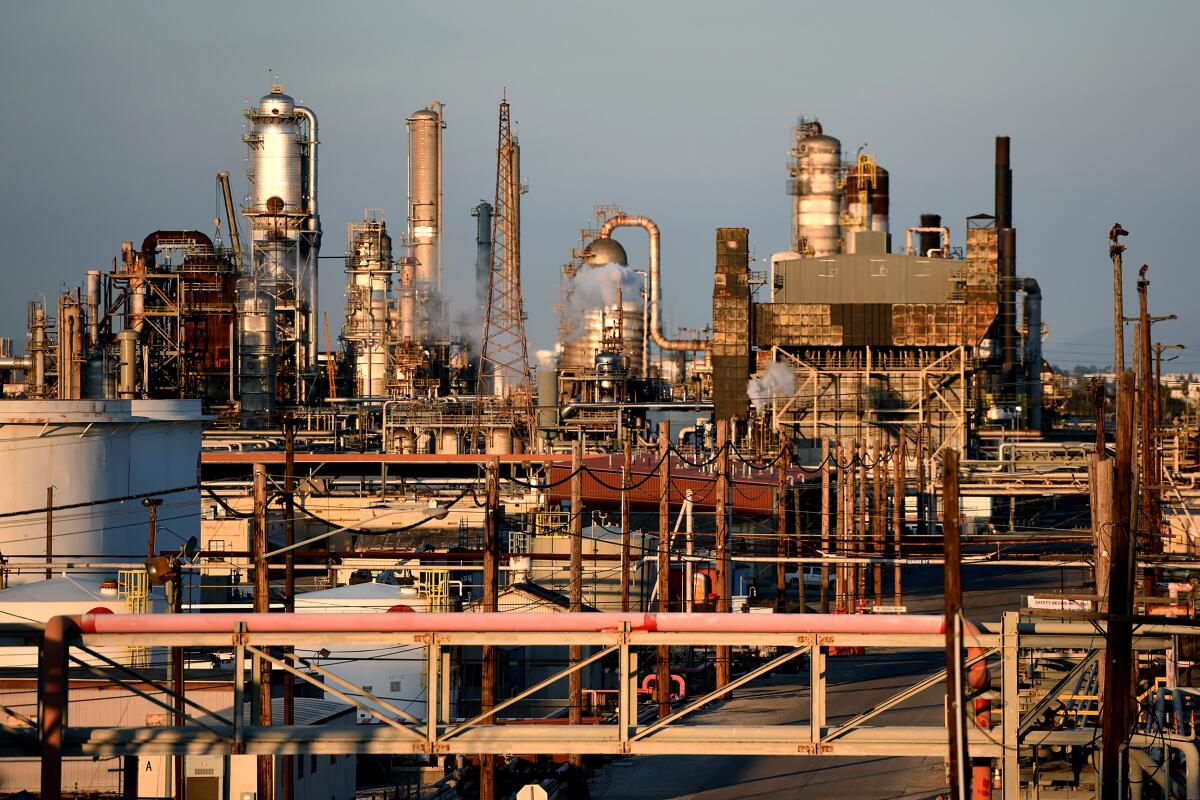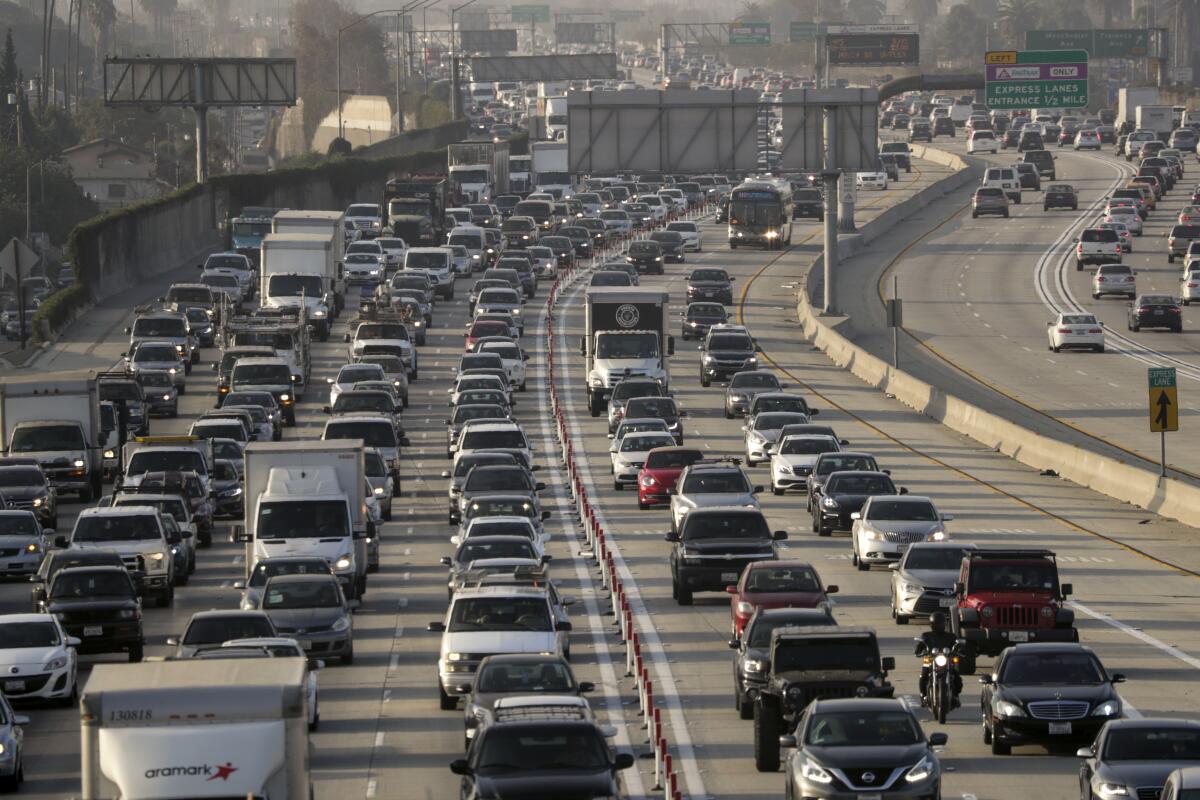The scary new climate report means fossil fuel use needs to start falling, fast

- Share via
The global climate report released Monday offered a dramatic reminder of the need to slash use of fossil fuels — not just by 2050, when many corporations have pledged to stop scorching the planet, but in the next few years.
Scientists have said that zeroing out planet-warming emissions by midcentury is needed to stave off the worst consequences of the climate crisis. But there’s a giant gap between the many companies that have pledged to achieve net-zero emissions by 2050 and the much faster action the new report makes clear is desperately needed.
For the record:
4:57 p.m. Aug. 10, 2021An earlier version of this article said Dan Sperling is a former air quality regulator. Sperling is a member of the California Air Resources Board.
“You can’t get to those kinds of ambitious emissions targets without getting to work now,” said Kim Cobb, a climate scientist at Georgia Institute of Technology. “There’s a mountain of change between where we are here and where we would need to be.”
Cobb was a lead author of the Intergovernmental Panel on Climate Change’s latest report. Hundreds of researchers contributed to the authoritative dispatch, which found that rising temperatures are already fueling worse heat waves, droughts, fires and storms — calamities Californians know all too well. The report built on earlier United Nations-backed science showing the world must cut heat-trapping carbon emissions nearly in half by 2030, and close to zero by the middle of the century.
Record heat. Raging fires. What are the solutions?
Get Boiling Point, our newsletter about climate change, the environment and building a more sustainable California.
You may occasionally receive promotional content from the Los Angeles Times.
The vast majority of climate pollution comes from burning coal, oil and natural gas. Rapid efforts to reduce reliance on those fuels would lead to noticeable benefits for people living in California and across the American West, Cobb said. She pointed to ever-larger wildfires and ocean acidification that is beginning to ravage marine ecosystems. They are climate consequences that have already arrived but could be limited, depending on what governments and businesses do next.
“The longer we put our foot on the gas here with emissions, the higher we’re going to push that damage,” Cobb said.
The list of companies pledging net-zero emissions by 2050 includes European oil majors BP and Shell, American Airlines, cement maker Cemex and food giant Nestle. A similar pledge is reportedly under consideration at Exxon Mobil, the Texas-based oil heavyweight that has known since the 1970s about its role in global warming but for decades denied the scientific consensus.
Experts say those kinds of pledges are potentially helpful but wildly insufficient. And many environmentalists have slammed them as little more than a marketing tool for companies trying to show off their environmental bona fides.

To Jonathan Foley, a climate scientist who leads Project Drawdown, there are two problems with net-zero goals. The first is they’re difficult to measure. “Net zero” technically means emitting no more carbon than you remove from the atmosphere, but Foley said this leaves a lot of room for companies to fudge the numbers.
The other problem is the timeline. Foley said he’s a lot more interested in what companies are doing now to cut pollution.
“What are your goals by 2021 or 2022? And who is accountable for that?” he asked.
That could be an especially difficult question for the oil and gas industry to answer. The Paris-based International Energy Agency released a groundbreaking report this year concluding that zeroing out heat-trapping emissions by midcentury means bringing new fossil fuel exploration to an immediate halt. That’s directly at odds with the industry’s long-standing business model.
“The best way to be net zero in this business is to shut down,” Foley said.
President Biden’s executive order pausing fossil fuel leasing on public lands sparked a fierce backlash.
The actual work of slashing fossil fuel consumption will look a lot different across different sectors of the economy — none of which is adding more carbon to the atmosphere than transportation, at least in the United States.
Carmakers including Ford and Nissan have trumpeted plans to hit net zero by 2050, with General Motors and Volvo aiming for 2040. Under heavy pressure from regulators in the Biden administration and globally, the auto industry has committed to invest hundreds of billions of dollars in electric vehicles and other clean technologies, including hydrogen fuel-cell vehicles.
But those commitments could change if consumers don’t step up — or if the companies have a change of heart.
While America’s three largest automakers stood with President Biden last week and set a goal of half of new car sales being zero-emission by 2030 — roughly in line with what scientists say is necessary to avoid the worst of global warming — that goal isn’t backed up by a government mandate. The industry already backtracked once before on a climate deal with President Obama.
John Loehr, managing director at consulting firm AlixPartners, said what happens next is largely up to drivers.
“Whether we hit these targets depends on consumer demand, on what the consumer wants to buy,” he said.

But what people want to buy could depend largely on how government addresses the main concerns with electric vehicles — namely range anxiety, lack of familiarity and prices, which are falling but still higher than for gasoline-powered cars.
California hopes to offer a case study for the rest of the country, with Gov. Gavin Newsom ordering that all new cars and light trucks sold must be zero-emission by 2035. But the state’s rebates and other financial incentives for people to buy electric vehicles are spread across several programs with hard-to-decipher requirements, and funding frequently runs out, forcing people to wait months for their checks. Federal tax credits, too, are running low and are more helpful for higher-income buyers.
“What we really need is to get everyone’s attention, get everyone focused,” said Dan Sperling, a California air quality regulator who heads the Institute of Transportation Studies at UC Davis. “This is urgent.”
Electricity is the country’s second-largest source of planet-warming emissions, and a crucial sector for rapid cuts especially as other parts of the economy — including transportation and home heating — shift from fossil fuels to electric power.
The list of utility companies promising net-zero emissions or 100% clean energy by 2050 includes multistate giants Dominion Energy, Duke Energy and Southern Co., as well as San Diego-based Sempra (the parent company of Southern California Gas Co. and San Diego Gas & Electric) and Ohio-based American Electric Power and FirstEnergy Corp.
“Electricity is the one sector I feel pretty good about,” Foley said. “Wind and solar are a pretty good way to make money.”
But many utility companies still operate coal-fired power plants that are among the worst polluters, in some cases with plans to keep operating them for decades. A recent Princeton University study on options for reaching net-zero emissions by 2050 found that coal “all but disappears” by 2030 under every scenario, and that natural gas probably must decline this decade, possibly as much as 30% — a reality at odds with the many utility companies pledging net-zero while building new gas plants.
President Biden wants the country to get 100% of its electricity from climate-friendly sources by 2035. Scientists say it’s possible, but requiring companies to achieve it may hinge on the vote of coal-state Democratic Sen. Joe Manchin of West Virginia.
California law, meanwhile, requires power companies to reach 100% clean energy by 2045. Gov. Gavin Newsom has acknowledged that timeline is inadequate and needs to be sped up, although his administration hasn’t yet taken steps to do that.
Some experts say there’s reason for optimism if the pressure on businesses keeps increasing — not just from government but also from employees, customers and investors. Even insurance companies are starting to take climate change more seriously.

Forty percent of the country’s 400 largest companies have made a commitment to go carbon-neutral in the coming decades, said Michael Vandenbergh, a law professor at Vanderbilt University who studies how corporations are responding to the climate crisis.
“I don’t want to underplay the fact that government really matters,” he said. “The way to evaluate private-sector action is not whether it’s a perfect solution, or will solve the problem, but to ask whether it can fill in the gaps to do what government should be doing.”
Companies in the tech and retail industries have led the pack. Microsoft says it intends to go not only carbon-neutral but carbon-negative by 2030, meaning it would remove more carbon from the atmosphere than it emits — a pledge that depends on a massive scaling-up of carbon capture technologies. Apple vowed that its entire supply chain will be carbon-neutral by 2030.
Walmart, the nation’s largest retailer, pledged in 2020 that it would eliminate emissions from its own operations by 2040, and since 2017 has been working to help its vast network of suppliers cut carbon. Amazon pledged two years ago to zero out its carbon pollution by 2040, in response to a massive employee walkout that called for the company to reach that goal by 2030.
But those types of goals don’t always result in the near-term progress that scientists say is badly needed. Amazon, for instance, dramatically increased its emissions in 2020 as demand surged during the pandemic, using 69% more fossil fuels for its own delivery networks and measuring nearly 30% emission increases for new equipment and third-party transportation.
Support our journalism
Your support helps us deliver the news that matters most. Subscribe to the Los Angeles Times.
Cynthia Cummis, who works with the private sector to set emission-reduction goals through the Science Based Targets initiative, said she’s encouraged by the more than 1,600 companies that have pledged to set targets that align with what climate scientists say is necessary, including AT&T, Pfizer, Sony and Visa.
“Now we’ve got to see if the commitments lead to validated targets and lead to actual achievement of the targets,” she said.
Unless companies can start cutting emissions now, climate advocates will be skeptical of 2050 pledges. The global nonprofit Oxfam International released a report last week labeling net-zero targets “a dangerous distraction that could delay the rapid reductions in emissions that high-emitting countries and companies need to make if we are to avoid catastrophic climate breakdown.”
Experts say there are big opportunities to reduce pollution now, if government and industry set their minds to it.
One of the biggest is methane, an especially powerful planet-warming gas that comes from pipeline leaks, oil and gas extraction, landfills and livestock, among other sources. It dissipates in the atmosphere more quickly than carbon dioxide but traps heat more powerfully in the interim, and it’s a focus of the Intergovernmental Panel on Climate Change’s latest report.
“We will land in very different places in 2050 depending on the near-term reductions that occur,” Cobb said. “The take-home from the whole report is that the risks increase with each increment of warming. If you don’t do that increment of warming, you will have a noticeable decrease in that risk. That’s really the bottom line.”
More to Read
Inside the business of entertainment
The Wide Shot brings you news, analysis and insights on everything from streaming wars to production — and what it all means for the future.
You may occasionally receive promotional content from the Los Angeles Times.














